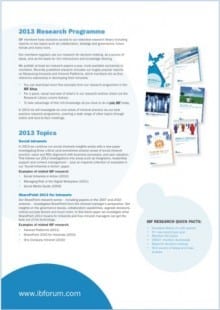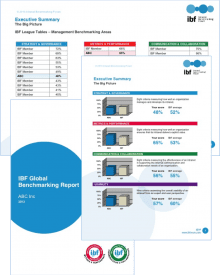Creating a better intranet news experience in SharePoint
 Guest post by Stacy Wilson of Eloquor Consulting
Guest post by Stacy Wilson of Eloquor Consulting
Stacy Wilson (@stacylwilson) is the Owner/President of Eloquor Consulting. Eloquor helps companies improve their internal communications, with a focus on intranet/portal projects and change management.
Stacy consults and speaks extensively about SharePoint, internal communications and related topics.
SharePoint out-of-the-box is – how can I put this politely – not very good at delivering and presenting news. I hear this routinely at conferences, from clients and from colleagues in professional organizations. Content issues aside, it’s safe to say the user experience in the platform isn’t close to delivering New York Times quality.
“But it’s just for employees,” you might be thinking. Wrong. Your employees drive your entire company and need timely, accurate and easy-to-use information to make the right decisions at the right time.
So what does good news look like?
eBizMBA Rank puts out a regular update of the 15 most popular news sites. Its ranking is based on an average of each site’s Alexa Global Traffic Rank and US Traffic Rank from both Compete and Quantcast. Here’s the August 2013 list:
[one_half]
[/one_half] [one_half_last]
- Huffington Post
- Fox News
- Washington Post
- LA Times
- Ok, we’ll stop there.
[/one_half_last]
Does your intranet news resemble any of these? If your organization is like most, intranet news doesn’t look remotely similar. And if you’re using SharePoint, the chances of this happening are slim to none.
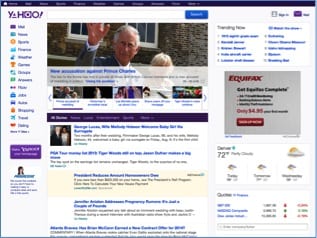
The Yahoo! news homepage
What makes intranet news good?
There are several key findings I’ve learned from nearly 15 years of usability-testing intranets:
- Employees think news is news is news – they do not distinguish between news from different organizational sources, but instead lump it all together.
- Most employees will not set up alerts or RSS subscriptions without a lot of prodding and support.
- Employees look for news primarily by topic, not by channel or date – I’ll look for “quarterly earnings” before I go to the “monthly blog”.
Other things we find useful in the news experience are:
- User ratings
- Dialogue to drive engagement (e.g. comments on news stories)
- The ability to temporarily elevate stories to greater prominence, and
- Management tools that handle approval and archival workflow and reporting.
Employees think ‘News is news is news’
Give employees a list of 100 items on the intranet, including 20 news stories from various departments, regions, executives, etc., and they will intuitively lump all news items together, as the following card-sorting exercise illustrates:
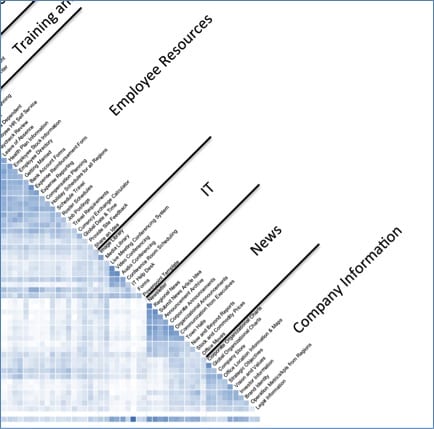
Snapshot of card-sorting results. These employees lumped all news-related items together and named the category “News”. The darker the blue the closer the relationship between the items.
This tells us that employees generally want to find all their news in one place, rather than having it spread across different sites.
Employees want personalized, relevant news
We also know from our research that when it comes to news, employees just want to see the stories they need for their everyday work and are personally interested in reading. This means delivering content based on individual profiles and enabling efficient subscription services. For example, we find in interviews and testing that some employees are interested in what we call “people news” – about promotions, new hires, etc. – while others couldn’t care less.
It’s the same with project news. I might be interested in Project Z, but really don’t care about the rest of the alphabet. Self-selecting my news focus is a productivity – and perhaps even a satisfaction – tool.
Filtering by topic
Filtering has long been an effective user-driven tool. It enables your employees to drill down to narrow their view. Given that it’s so helpful for news delivery, why save it for search results only?
Providing topical channels (versus media channels such as “blog”, “podcast” etc.) helps employees find what matters to them in the news center.
How SharePoint 2010 & 2013 measure up
We’ve looked at patterns of employee expectation and what makes for good intranet news. The big question is: how well do SharePoint 2010 and 2013 meet these demands?
Central publishing site for news vs. news everywhere
SharePoint delivers the capability to publish news on any site – team site news, department site news, region site news, publishing site news. But this isn’t how your employees think about finding news.
While SharePoint hasn’t yet delivered a “news” site configuration as of yet, it’s pretty capable of delivering a decent integrated news experience through a publishing site. But if you’re tempted to throw newsy web parts everywhere – try to resist. A better solution is to use a web part that refers to content on the primary news site in a special filtered view for other team or project sites.
Targeted news based on profiles
If you have quality information about your users in the Active Directory, then SharePoint is actually pretty terrific at delivering content based on individual user profiles. We typically see content targeting based on the following factors:
- location (e.g. region, city, country, etc.)
- level (e.g. manager, executive)
- function (e.g. department, team).
So, if I’m an engineering manager in Sydney, I can in theory see a different version of the news center than an individual contributor in the Singapore Finance department.
Hey SharePoint: make RSS easier to use!
Where SharePoint out-of-the-box falls down is in subscription services. Nearly everything in SharePoint (e.g. lists, libraries, etc.) can deliver an RSS feed. And all of these items can send an alert when things change. However, we find the vast majority of users never set up an alert or subscribe to the RSS feed because it’s just too hard and confusing to do.
Some organizations implement third-party tools to make this easier. Newsgator is the classic example of turning subscription services in SharePoint into a one-click experience. Unfortunately, this requires a lot of configuration and delivers the capabilities across all sites, not necessarily giving users a one-stop-shopping experience for news.
Bringing it all together
To really make news work effectively in SharePoint you need to bring everything together into one easy-to-use, integrated approach. A third-party example of this is ElevatePoint News, a tool that leverages and enhances SharePoint’s ability to manage and deliver news.
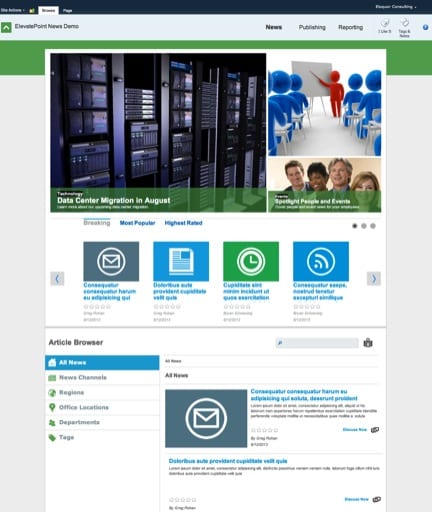
Demo site built with ElevatePoint News, created by Coldwater Software.
Here you have news integrated into one experience, including simple rating and subscription services, topical filtering and the ability to customize based on user profiles and groups. Add some workflow to the management tools behind the scenes (which I think Microsoft is working on) and you’ve got a tool that’s as easy for the communication team to manage as it is easy for users to consume.
Other SharePoint add-ons that can help deliver a better intranet news experience include: Attini, Newsgator, Tibbr, Vinewave.
How some companies nail SharePoint news in-house
Some organizations create home-grown versions with beautiful graphics and cool Apple-like carousels. The ones who do it well ensure:
- there’s a one-stop-shop option for browsing and finding news
- subscription services are super easy to use
- users see a custom version of news based on who they are
- filtering enables refinement by topic, not just communication channel
- rating news is easy and leveraged for crowd-sourcing (lifting the most popular stuff to the top)
- readers are engaged in dialogue through comments
- management tools make life easy for authors and publishers
- reporting proves the return on investment.
Whether you build your own or buy a great solution, your employees will thank you and be more productive as a result of having more effective news.

RESEARCH AND RESOURCES
- FREE EXECUTIVE SUMMARY: Office 365: What digital workplace teams need to know
- FREE EXECUTIVE SUMMARY: The changing role of Internal Communications
- FREE REPORT: Digital workplace integration: Key approaches to drive benefits
TAKE THE NEXT STEP
Access DWG’s 70+
research reports
Categorised in: Internal communications, Intranets
 Guest post by Stacy Wilson of Eloquor Consulting
Guest post by Stacy Wilson of Eloquor Consulting